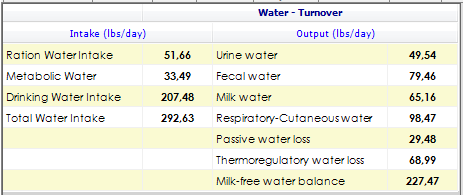
A third aspect allowed by NDS Water Sub-model is related to the water metabolism and turnover.
It is well known that lactating dairy cow normally metabolize large amounts of water and are rapidly affected by water deprivation. Water metabolism has dynamic nature and water is of paramount importance both physiologically and nutritionally; therefore, its metabolism may indirectly affect many feeding and management decisions. Dairy production systems are, by definition, water intensive and should be managed accordingly: abundant water of acceptable quality must be provided to maximize milk production. Milk and waste products (urine and feces) also contain large amounts of water.
From a metabolic standpoint, water is lost in milk, urine, feces, and various forms of evaporation. Sources of water include drinking, feed, and metabolic (oxidation) water.

Given the importance of water metabolism, NDS Water Sub-model provides an overview of Water Turnover through the several items that make up water intake and output.
The intake of water is described as Total Water Intake (TWI) that is the sum of drinking (or free) water intake (FWI), water contained in feeds (RWI) and water produced by the metabolic oxidation of nutrients (MWI).
The output of water (Water Turnover Output – WTO) is more complex and includes urine water, fecal water, milk water and respiratory-cutaneous water (RCW). Loss of RCW can be separated into Passive and Thermoregulatory components (Silanikove et. al. JDS 80:949,1997). Passive water loss is respiratory loss plus cutaneous diffusion loss, while the Thermoregulatory water loss is activated by panting and sweating where sweating constitutes the major component of total evaporation under heat stress conditions.
The Milk-free water balance (MFWB - water turnover output minus water secreted in milk) describes a way to check the water balance and, obviously, for pre-partum cows, MFWB is equal to the WTO rate.
Although not consolidated guidelines, in order to properly evaluate the water balance for lactating and dry cows, we may suggest that water supply (RWI + DWI) should be higher than MFWB and also, DWI should cover at least 90% of the Milk-free water balance.
Also, water and ion balance are closely related and the high levels of milk production are accompanied by a marked increase of ions secretion. A surplus intake of ions increases the demand for water, and water lost during thermoregulation is accompanied by ion losses. We know that the balance of ions in dairy cows is always negative under the hot summer conditions, therefore, water plays an important role in the efficiency of thermoregulation of the cows in hot climates, even affecting milk yield.
This is a promising area of evaluation related to the Water turnover that might be interesting to explore for a future model development.